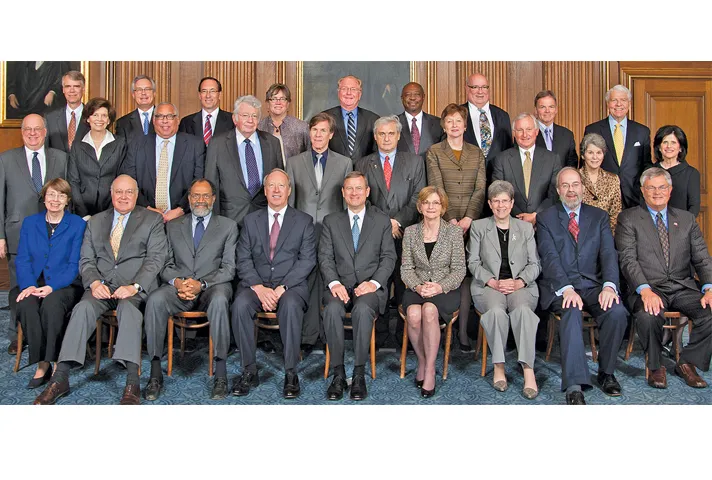
Seated: (LtoR) Chief Judge Sandra L. Lynch (1st Cir.); Chief Judge Dennis Jacobs (2nd Cir.); Chief Judge Theodore A. McKee (3rd Cir.); Chief Judge William B. Traxler, Jr. (4th Cir.); Chief Justice John G. Roberts, Jr.; Chief Judge Edith Hollan Jones (5th Cir.); Chief Judge Alice M. Batchelder (6th Cir.); Chief Judge Frank H. Easterbrook (7th Cir.); Chief Judge William Jay Riley (8th Cir.). Standing, Second Row: (LtoR) Chief Judge Mark L. Wolf (D. Mass.); Chief Judge Carol Bagley Amon (E.D. NY); Chief Judge Gary L. Lancaster (W.D. Pa.); Chief Judge David Bryan Sentelle (DC Cir.); Chief Judge Randall R. Rader (Fed. Cir.); Chief Judge Alex Kozinski (9th Cir.); Chief Judge Mary Beck Briscoe (10th Cir.); Chief Judge Joel F. Dubina (11th Cir.); Chief Judge Deborah K. Chasanow (D. Md.); and Chief Judge Sarah S. Vance (E.D. La.). Standing, Third Row: (LtoR) Judge Thomas A. Varlan (E.D. Tenn.); Chief Judge Richard L. Young (S.D. Ind.); Judge Robert S. Lasnik (W.D. Wash.); Judge Robin J. Cauthron (W.D. Okla.); Judge Rodney W. Sippel (E.D. Mo.); Judge W. Louis Sands (M.D. Ga.); Chief Judge Royce C. Lamberth (D. DC); Chief Judge Donald C. Pogue (Int’l Trade); and Judge Thomas F. Hogan, Dir, AOUSC.
Contact: David Sellers, 202-502-2600
Following on the heels of a cost containment summit convened last fall, the Judicial Conference of the United States today approved a series of money-saving initiatives in an effort to prepare for funding levels that will otherwise cause significant reductions in staff and court services.
A number of Conference committees, in particular all those with spending authority for specific programs, have focused their agendas on containing costs. In recent years the committees have worked to implement cost savings in areas such as personnel, space and facilities, information technology, and general operations.
"The Judiciary is on the cusp of a financial crisis of significant proportions, one that I believe we can assuage somewhat if we are willing to take bold and unprecedented action," Judge Julia Gibbons, chair of the Budget Committee, told the Judicial Conference.
Today the Conference agreed to ask Congress to approve legislation to drop some duplicative procedures or requirements for probation and pretrial services. For example, one proposal would allow a court to waive electronic monitoring of certain defendants if more restrictive measures, such as residence in a halfway house or treatment facility, are part of the court's pretrial release order.
The Judiciary is concerned about the impact of congressional budget cuts on its ability to maintain clerk's office and probation officer staffing levels at a time when the workload is not declining. It is especially concerned about the impact of the Budget Control Act, which requires automatic across-the-board spending cuts to take place in January 2013. If Congress does not agree to a deficit reduction plan or amend this "sequestration" requirement, the courts could lose more than one-fourth of their workforce, civil trials could be suspended for months, funds to pay panel attorneys who represent indigent defendants would expire well before the end of the fiscal year, and court security could be severely compromised.
In the current fiscal year, FY 2012, most of the Judiciary, including the account that pays for operation of the courts, was funded at the same level as FY 2011, despite increasing requirements. The FY 2011 funding level for the court operations account is essentially the same as it was in FY 2010, which means this account has been frozen for three years.
As a result of the already constrained funding levels and concerns about future funding, courts have reduced their staffing levels by about five percent and the Judicial Conference and its committees, with in-put from the courts, are continuing to explore all cost-saving options.
"We recognize that making these decisions will not be easy, and may result in less than optimal results. But the fiscal situation likely will require us to make difficult choices," Judge Gibbons told the Conference. "The alternative is the increasing likelihood that the Judiciary will lose thousands of additional court support staff, which will fundamentally and negatively impact the core work of judges, the courts, and the Judiciary."
The 26-member Judicial Conference is the policy-making body for the federal court system. The Chief Justice serves as its presiding officer. Its members are the chief judges of the 13 courts of appeals, a district judge from each of the 12 geographic circuits, and the chief judge of the Court of International Trade. The Conference meets twice a year to consider administrative and policy issues affecting the court system, and to make recommendations to Congress concerning legislation involving the Judicial Branch.
Subscribe to News Updates
Subscribe to be notified when the news section is updated.
